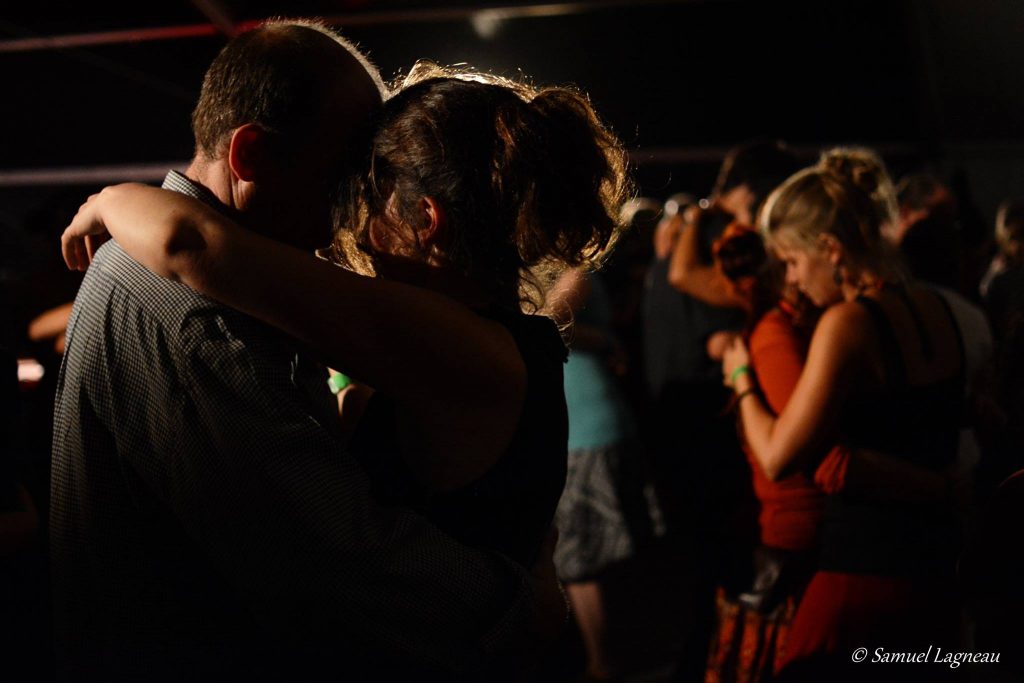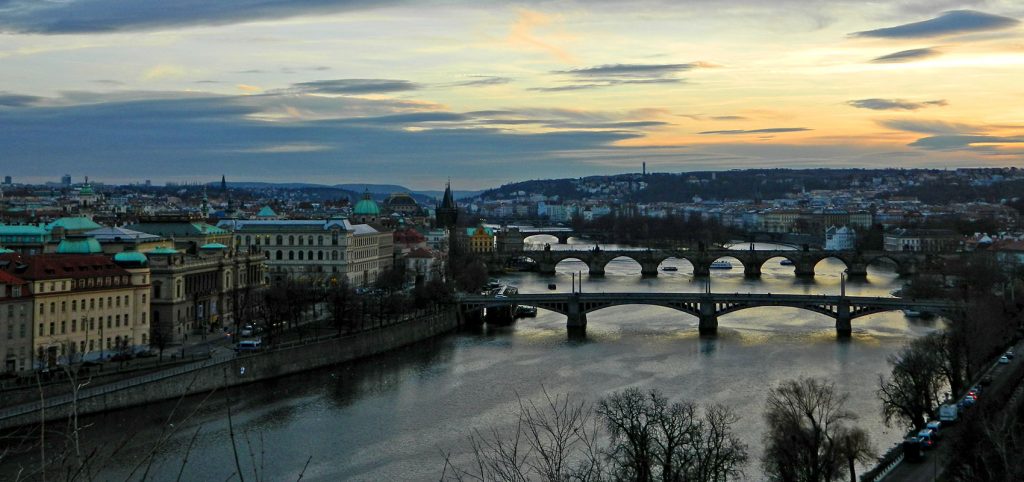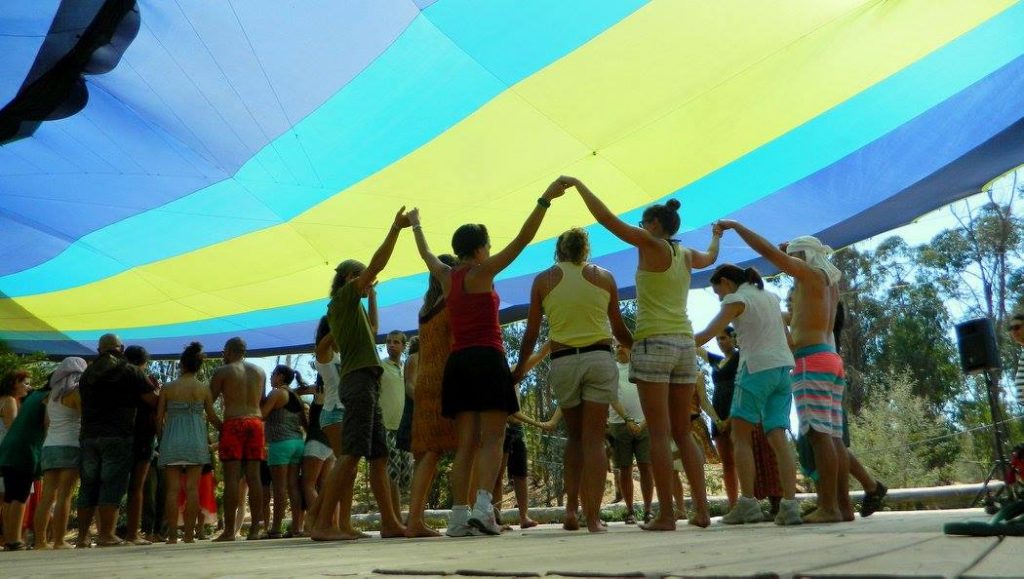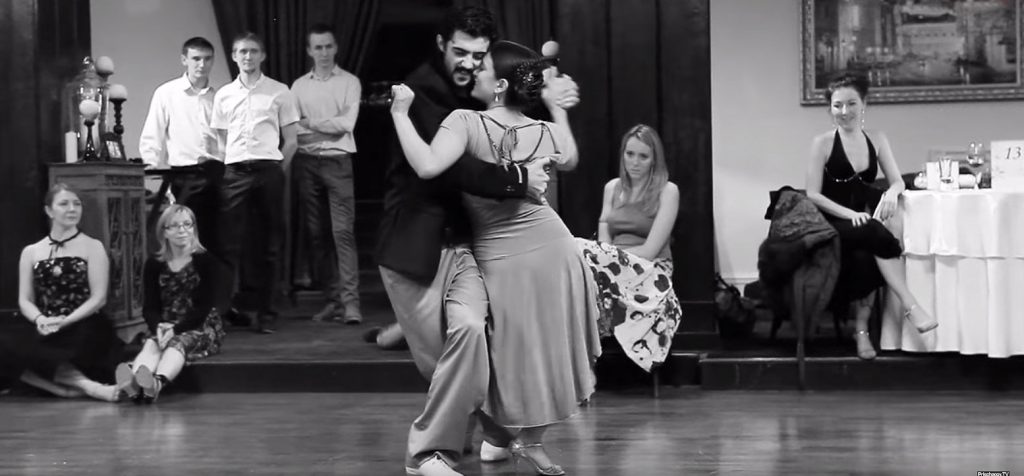The band announced a mazurka. The room is filled with people looking desperately for a partner. “I always dance the first and the last mazurka with my girlfriend / boyfriend” say some people. With years passing, I have the feeling that bal folk’s couple dances, especially mazurka, are transforming under a “romantic effect”. Melodies are tender, tempos are slower, bodies are closer… and the tango slightly makes an entrance…
Mazurka’s metamorphosis, a study by Eric Thézé
The mazurka is one of the most popular dance in bal folk today. One of the 4 main couple dances : mazurka, scottish, polka and waltz. It is probably the dance that evolved the most and the quickest since its creation. Some major evolution in its musical approach, in the manner of dancing it and in its popularity.
In 2006, Eric Thézé, dancer, musician and composer of many mazurkas, wrote a study untitled “Les Métamorphoses de la Mazurka”. He describes the roots of the mazurka dance as following :
The Mazurka is born in Poland.[…] During the years 1830, a lot of Polish, chased and hunted down from their home after the division of their country between Prussia, Austria and Russia, emigrate toward Western Europe. Amongst them, Frederick Chopin set up in France and by his numerous compositions and performances, contributed to the mazurka’s fame.[…] First danced in the high society, the Mazurka spread out in the different regions of France and takes different forms.
Eric Thezé
Mazurka Metamorphosis Practices from traditional inspirations and teaching, by Eric Thézé. This text was presented during a seminar of the research department of the French-British relations, University of Lancaster, and a meeting around the mazurka, organized in April 2006.Les Métamorphoses de la Mazurka - Eric Thézé
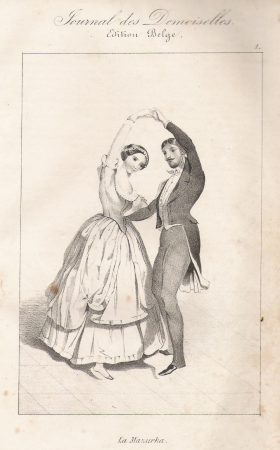
We therefore have the vision of a lively and codified dance, far from the languorous rhythms we hear today on the dancefloor. So what happened ?
The beginnings of that young dance that came from Paris were eluded by collectors, more focused on local dances from the countryside (richer) until the seventies in Samatan, a little village from Gascony (South West of France) is noticed amongst other versions. Pierre Corbefin, Director of the Occitan Conservatory recorded it, and then teached it, spreading it and making it popular. Eric Thézé writes :
One of the characteristics of that mazurka is that it is less jumped than the others. More flowing or sliding, it didn’t have that joyous and bouncing aspect you could see elsewhere.
Eric Thézé
We were already quite far from the mazurka from the victorian society and the comfortable “salons” of Chopin. The mazurka already transformed for its first major evolution.
The new bal folk “slow”
These past 20 years, we saw a new main evolution coming, distinguishing the mazurka as one of the main dances of folk, the slow and romantic song. The bal folk new Slow.
For twenty years, from 1970, the image of the mazurka transformed thanks to Pierre Corbefin and to answer to the dancers demands. It happened a conjunction between a collective mechanism and an individual initiative. That collective mechanism operated with the development of couple dances. Gradually, the proportion of couple dances in a ball increased, people started to ask for more sensual dances, not only entertaining, but permitting to improvise freely.[…]
In the years 1980 to 1990, some musicians, or deciding to answer to people’s demands, or because they just felt like it, started to play mazurka to a slower tempo, promoting a manner of dancing more flowing than jumping, and much more adapted to the dance teached by Pierre Corbefin and his students.
Clearly, I think that new generations of musicians and dancers, and the evolution of the music for dancers (like broached in The amazing creativity of bal folk music ) had a huge effect on the way we are dancing today. As musicians were influenced by music from abroad, dancers were influenced by other dances like tango, salsa, contact dancing, rock n roll …to spice up their dance.
Eric Thézé allude to festivals and their night jam sessions as the incubators of these transformations…
Because at night, after the disappearance of the sound system, between 3am and dawn, musicians and dancers can express themselves freely, without thinking, in a more intuitive way. The same dancers whose role during the day is to speak up and explain the dances during their workshops, transmitting something more than steps and figures. The energy that enliven them, can push away the weariness, give them all the hope to see the sun rise. Meanwhile, because they will have to analyse and transmit, they make their own representation of the dance evolve, they will create new variations where they just experimented without words. These new variations will be applied by their students in a mechanical way, because it will be explained, quantified, fixed… Until they, themselves, will be drag to the nocturnal practice. They will then drop their own practice and what they learned before, to experience dancing on their own.
More and more, the idea to focus on connection between dance partners instead of doing little jumps, makes its way amongst the dancers.
Mazurka is a dance in 12 tempos on a musical phrase. Tempos 3 and 9 are marked in the air, usually a small jump. The new tendency is to jump less, the marked tempo being now a small pause rather than a vertical impulse. Some dancers use that energy horizontally, roundly , instead of vertically, to increase the speed of the turns, and creating new variations.
As the music becomes more and more intimate, new tunes follows that scheme…
When tango shows up in our dance classes
Frisse Folk January 2002, Koen Dhondt starts giving folk dances lessons in Bruxelles. 15 years later, Frisse Folk has become a reference for folk dances in belgium and a dance school of solid reputation. Koen Dhondt is the founder and president of the society. Since 2011, he is assisted by the multilingual, polyvalent Elena Leibbrand in the organisation of dance classes, workshops and numerous balls. [More about Frisse Folk]
There are many workshops of variations for mazurka, allowing dancers to spice up their dance, experiment and open the horizons of dancing. Koen Dhondt, folk and traditional dance teacher in Bruxelles, proposes some of these workshops. Teaching in Belgium for 15 years under the banner of Frisse Folk, he organises Tangurka workshops regularly with his dance partner Elena Leibbrand.
Last november, Frisse Folk organised a ball with Duo Absynthe, the ultimate “romantic” band , and in the same time proposed a workshop about mazurka tango. Do you see mazurka as a romantic dance ?
I don’t know if we can define Duo Absynthe as a romantic band but they indeed play slow mazurkas, as a lot of bal folk bands / neo folk bands in Europe. It can create romantic atmospheres, and it influences the dance as well as we will dance and interpret differently depending on the tempo.
Even if there are dances that, clearly, create an intimacy between two people, we shouldn’t associate all the mazurkas to the word romantic. It would be restrictive, especially as historically it was danced very differently.The tempo was much faster, the steps were much more marked and bouncy. Some bands still play it that way.
The techniques we wish to transmit are not in the idea of making the dance romantic. It is an ensemble of keys to play with your dance partner. Folk dancing means you can add and mix new techniques to make your dance richer.
What can we learn from tango ?
Notions of posture of course, but it is something we work from the beginning at Frisse Folk. In tango you have possibilities that does not exist in bal folk : different techniques and position, we try to mix it all. First of all, I am interested in little tango techniques we can use easily in couple dancing. It’s working great in slow mazurka but it can be used in other dances as well like scottish, valse, polka, etc. to improvise and explore other techniques.
In mazurka you have a lot of steps in rotation, we will add movements forward and backward, eventually notions of dissociation of the upper body and the hips.
Is it a way to bring people to tango ?
It can be a soft transition for some people. Tango is a very popular dance, and there are a lot of people we a good level of mazurka who are looking for new things and greater technical skills. That’s why I wanted to propose these workshops. The first workshop I gave, it was with a friend, a tango teacher. We danced a lot, experimented steps, elaborate a transmission… Always in the idea of keeping the pleasure of dancing and improvisation. Transmitting notions of tango through a dance people already know, for many it is a first approach without complexes.
Mixing mazurka and tango, is it still a mazurka ?
We dance so many mazurkas that, after awhile people want to do things differently from time to time. We push the limits, sometimes it works, sometimes not. I allow myself to make experiments to a point where we can say the notion of mazurka is lost. We will work on a combination and transition from the basic step to tango, and reverse.
We don’t want the label of “tango mazurka teachers”. Yes, we teach it sometimes but it’s not the only thing we do. I have a traditional side and a huge respect for it. For me, folk dances and traditional dances are not black or white. It’s a spectrum with a lot of shades in it. These workshops might be the most “folk” I do. A workshop of Branle Béarnais will be on the opposite side and I appreciate to do both.
So there is not opposition between “folk” et “traditional” ?
For me, the word “trad” or “traditional” is used to point out the way dances were practiced in the rural society. There is a patrimony to keep and to save and it’s very important. And I call “Folk” that actual current where you can take liberties and distance with what was danced at first. It is a field where we can bring a different kind of amusement and creativity, mixing new things.
I am an adept of traditional dances as well. I try to apply that aesthetics and rigor to the countryside dances : congo, branle, bourrées, bourrées auvergnates… Meaning dances from a specific region, more or less preserved and transmitted until now. I try to transmit it in a correct way. Then, to people who really master it, we try to go further and bring some variations, more personal, with more creativity. But for dances from the 19th century like mazurka, scottish and valses, that does not belong to a precise spot and is not in a repertory to maintain, then I have a free attitude.
A conscious choice
There’s nothing wrong to let influences from outside open our possibilities in dancing. Still, Koen is in favour of a conscious choice. A deliberate choice of following the basic step or not, but as a root to know your basics and what you are doing.
Yes, the dance is alive. Some people say “If you’re improvising you can do whatever you like…” It’s not an excuse to do nonsense, sometimes without knowing the original steps. I think the traditional dance society was evolving as well but because people mastered their basis so well they finally added a personal style to it. Today, some people don’t even make the effort to learn the roots of their dance, or they didn’t meet the original version : they saw the copy of a copy. They might start creating something else before even integrating the basics, but that’s not an evolution it’s a break.
An evolution that doesn’t fit for everyone
Like many dancers, I’ve heard a lot of negative remarks about people stepping outside the basic to flirt with other dances like tango or salsa. First I would like to say that, if it doesn’t hurt or trouble the good continuity of the Ball and well-being of the dancers, then everyone is free to dance however they like, even in a very crazy way. The most important being in symbiosis with each other and the music. I would personally avoid contact dancing on traditional mazurka, but your choice… Everyone is responsible for its own musicality only.
A recurrent reproach is about the word mazurka in itself who would be misused today, the contemporary mazurka not being mazurka anymore. So we should use another word to define it… I believe that a word used by thousands of people, dancers and musicians, cannot be wrong. There is not one mazurka but mazurkaS and the new generation is part of it. In the end, everyone will probably defend the version they are used to. Was it traditional mazurka after all ? Everyone will have its own interpretation, is it the quadrille version ? The jumpy one ? The non-jumpy one but without fancy variations ? The non-jumpy one but with variations pre-1980 ?
First, I believed that Samatan’s mazurka was just being distorted by bal folk dancers, like many other dances before […] But I finally realized that dance wasn’t “deformed” but “metamorphosed” in various form, here and there, maybe with excesses, maybe with failures, but mostly beautiful successes, to watch and to feel, to share with other dancers […] In a traditional transmission, no one dance reproducing an analysed scheme, no one dance exactly the same way, as no musician play the same way.
Eric Thézé
We, dancers, choose our dance frame. It seems clear that in a social dance, openness towards influences should be accepted. That a certain strictness might be asked in a context of re-enactment is something different.
If we dig in criticism a little, an other echo that comes out sometimes – and this is an important one- is the imposition of physical proximity. Originally mazurka is dance in the “open modern position”. With music and steps slowing down, dancers are getting closer, and everyone is not at ease with that. We reach there the notion of consent. It isn’t only about mazurka of course, but within a dance where people get closer when before it was not, we have to make sure our dances partners are ok with that. Being uneasy when you dance is not acceptable and the subject is so vast I send you to another article I wrote about it : Engage your body into the dance

I hear sometimes the words marshmallow mazurka, dirty mazurka, etc. I don’t know if it’s a trend that will last, and very likely that each dancer has an experiment and a marshmallow period, but it’s at that point that introduction to tango seems especially useful to me. Tango being the close embrace dance by definition, the relation to the partner and the dance posture has been studied, codified, and allows people to dance together in good conditions. We can evolve for years in folk dances without taking any lessons, and have a bad posture all the way, so I believe that opening our horizons to tango and its rigor might be very welcome.
Mazurka isn’t suppose to be close embrace, we should start with the idea of dancing in modern position, then get closer in the dance if 1/ the partner allows it 2/ music too. Variations are fun, but simplicity and smoothness of the basic step and an agreeable connection is just a challenge in itself.
Probably that dance isn’t done with its evolutions in the future. In 20, 50 years maybe, we will have a better view on how a social practice can change a dance.Will we fusion with tango argentino, salsa or contact dancing ? Will there be a new trend ? Will we find another name for that new dance ?
